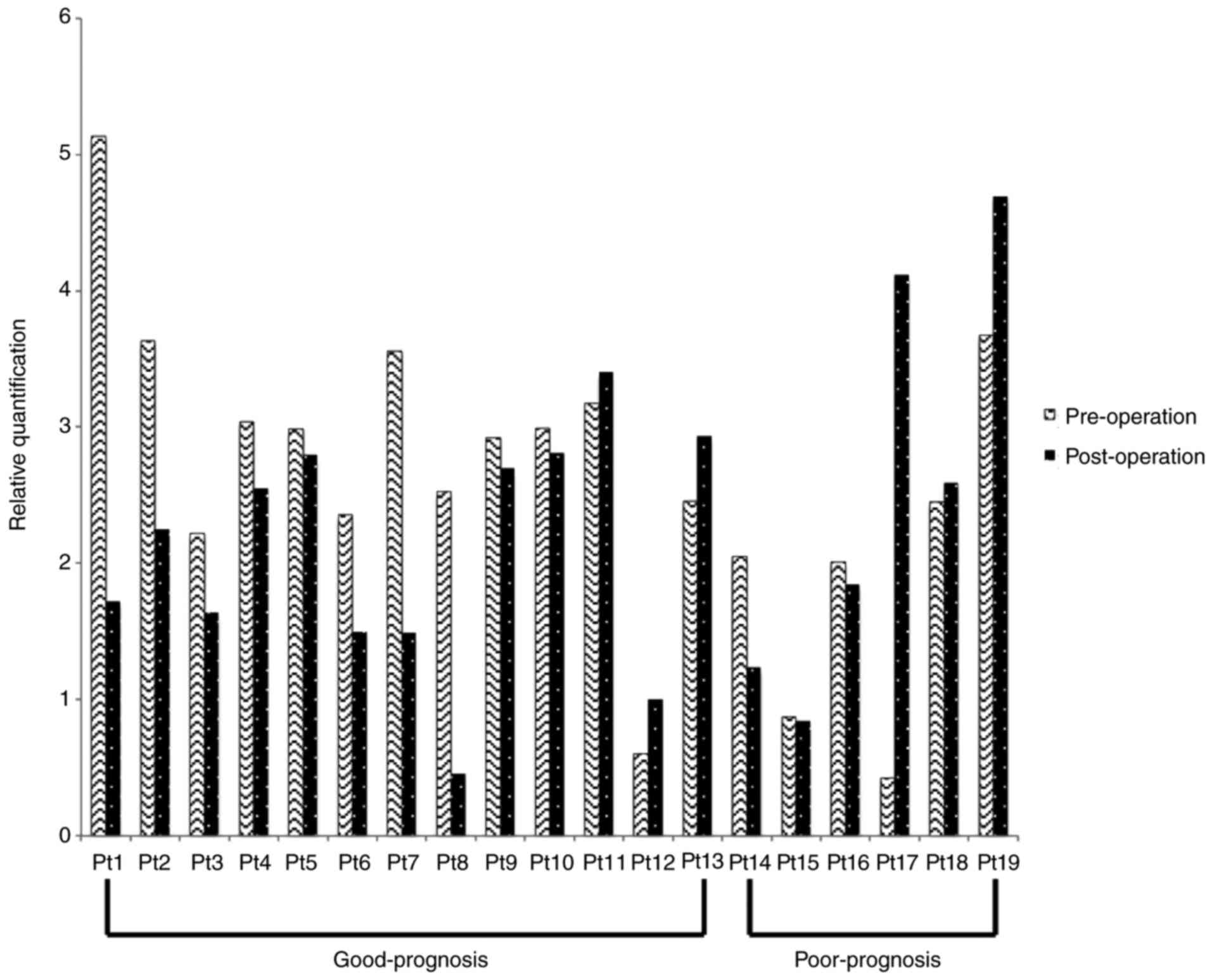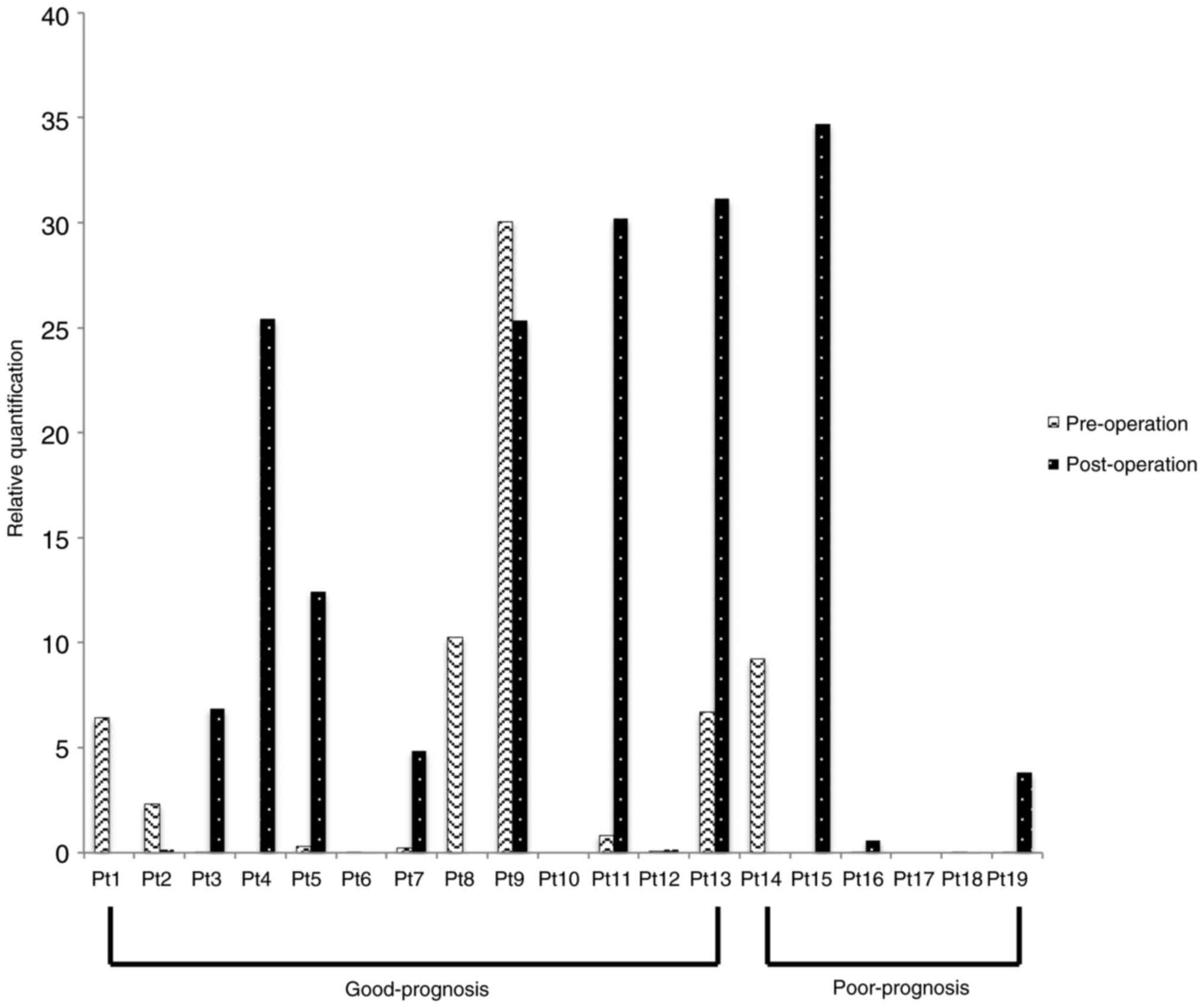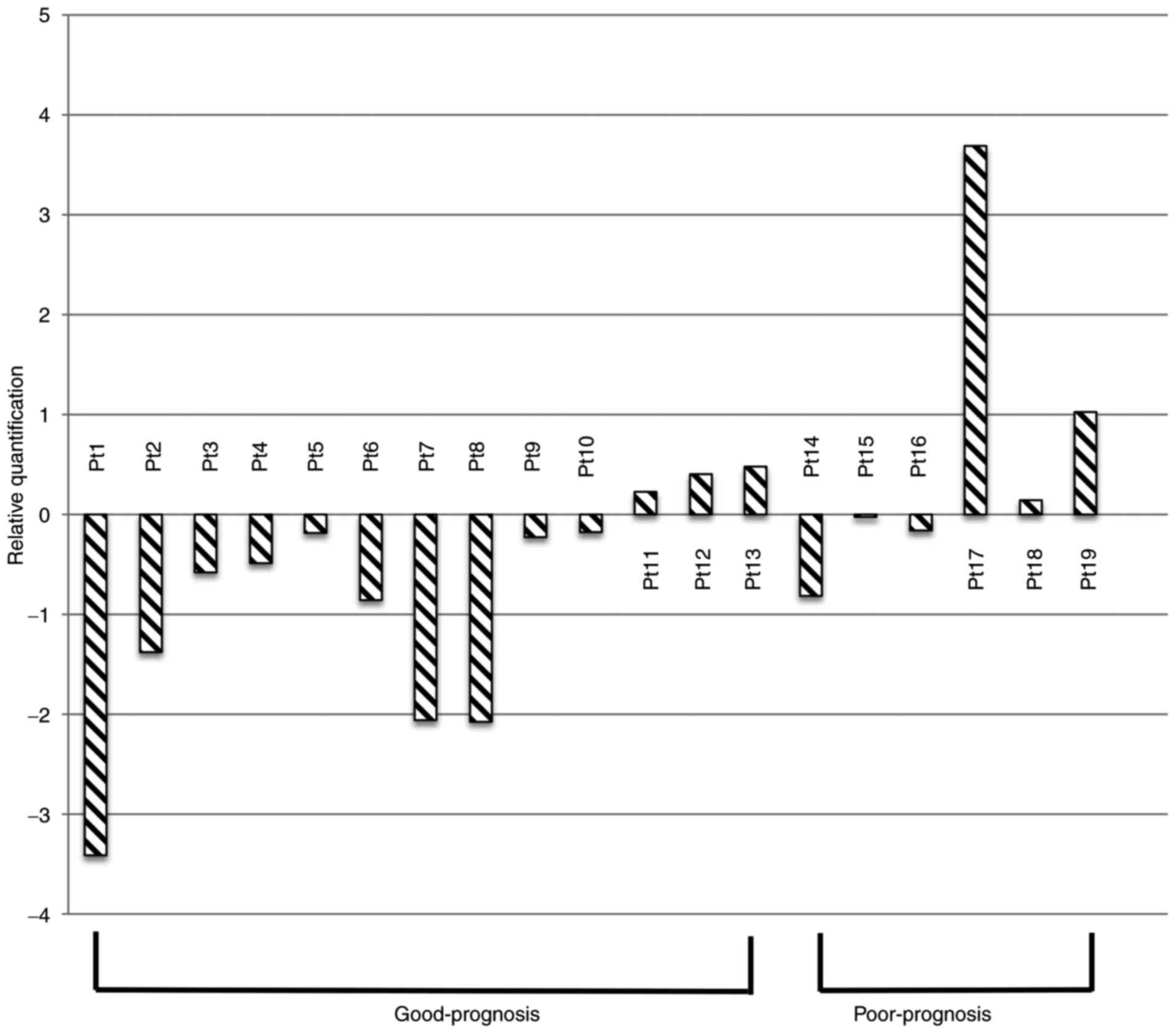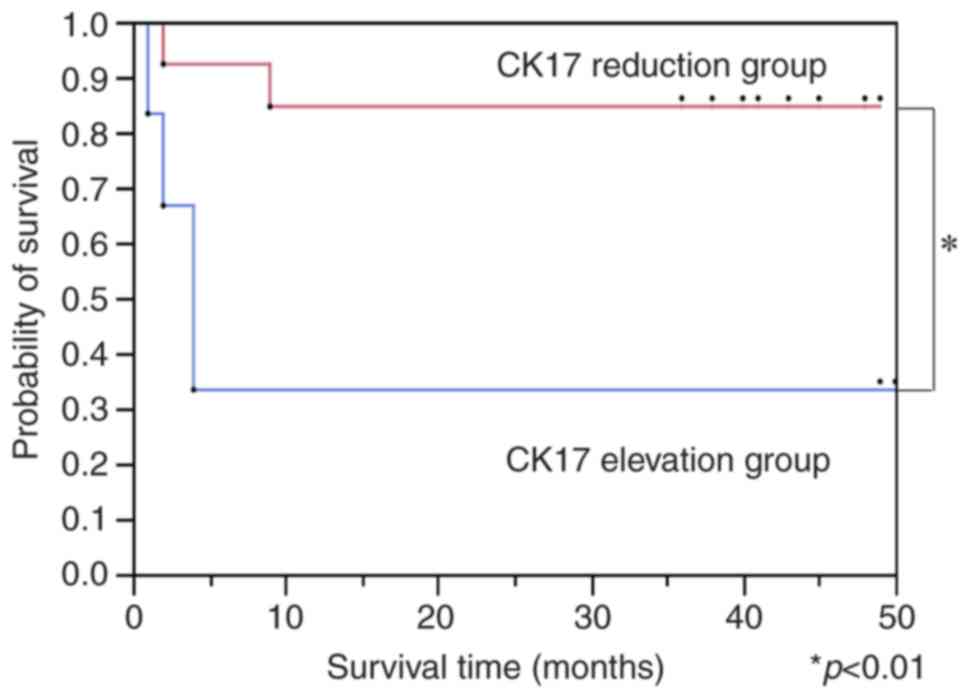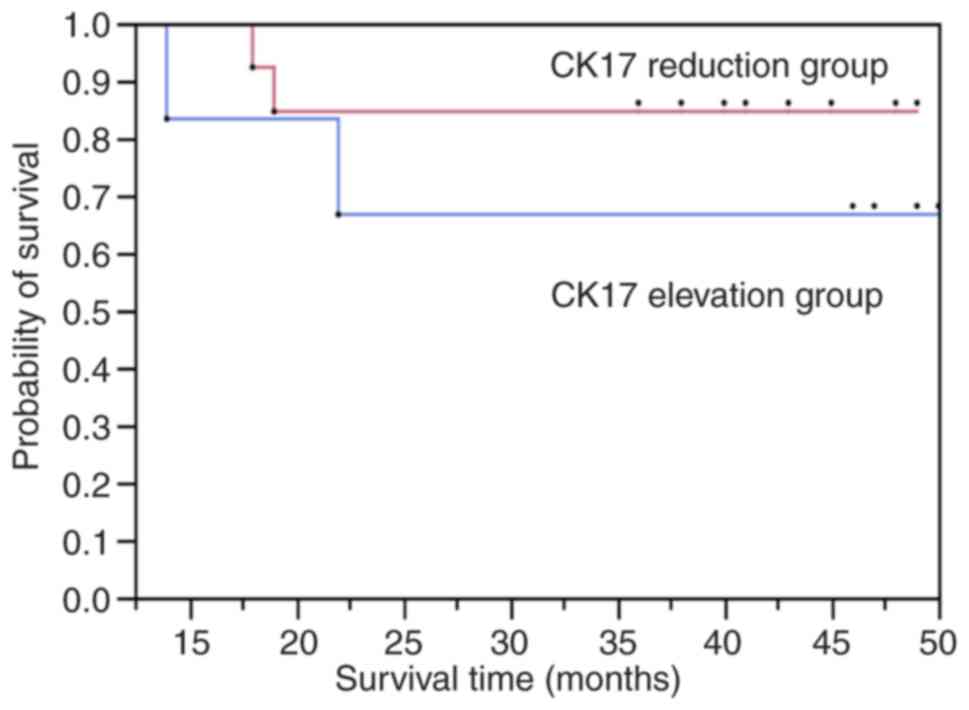Cytokeratin 17 mRNA as a prognostic marker of oral squamous cell carcinoma
- Authors:
- Published online on: September 26, 2017 https://doi.org/10.3892/ol.2017.7066
- Pages: 6735-6743
-
Copyright: © Kitamura et al. This is an open access article distributed under the terms of Creative Commons Attribution License.
Abstract
Introduction
Despite both diagnostic and therapeutic advances, such as combining surgery, radiotherapy and chemotherapy, the 5-year survival rate of oral squamous cell carcinoma (OSCC) remains between 70–80 % (1–3). This is primarily due to recurrences and secondary metastases to cervical lymph nodes. Furthermore, it is difficult to detect these recurrences and the metastases, postoperatively, thus patients receive significant post-operative monitoring. As early detection of recurrences and secondary metastases in the cervical lymph node is key to good prognosis and low morbidity in the follow-up period, reliable prognostic OSCC biomarkers are needed. To date, there are no specific biomarkers that can be used to post-operatively monitor OSCC patients.
The failure to reduce morbidity in OSCC patients most likely results from the early dissemination of tumor cells into bone marrow or peripheral blood (4–7), which is usually missed by conventional staging procedures at the time of surgery and leads to recurrences and metastases. Adjuvant therapy can eradicate occult disseminated tumor cells (DTCs) before recurrences or metastases become clinically evident; thus, there is an urgent need to develop strategies to detect DTCs and enable clinicians to identify patients who would benefit from systemic treatments (8–12). A few studies have used RT-PCR-based techniques to detect epithelial cell-specific mRNAs (13–16) and have revealed the presence of circulating epithelial cells, supposedly derived from the primary tumor, in the peripheral blood samples from OSCC patients.
Cytokeratins (CKs) are intermediate filaments of the cytoskeleton that are overexpressed in OSCC compared with normal mucosa (17), and thus, are candidate prognostic markers for OSCC. Recently, CK17 was identified as a diagnostic marker for primary OSCC (18,19) and as a specific immunohistochemical marker in SCC of the larynx as well as breast and cervical carcinomas (20–22). The presence of CK19 mRNA in tissues by real-time RT-PCR may be a prognostic marker for OSCC (23). Furthermore, CK19 mRNA and CK20 mRNA have been extensively investigated as means of detecting DTCs in the peripheral blood and bone marrow of breast, colorectal and pancreatic carcinoma patients (8,24–26). Moreover, CK20 expression in primary OSCC tissues was associated with the occurrence of metastases to neck lymph nodes (19,27), and in poorly differentiated adenocarcinoma, CK20 expression is closely associated with invasive histological features and has prognostic value (28).
Although several studies have examined CKs as OSCC diagnostic markers, few studies have investigated them as prognostic markers for OSCC. During the follow-up period, it is easy to harvest peripheral blood from OSCC patients, and our hypothesis is that CKs in the peripheral blood may predict recurrences and metastases. The aim of this study was to determine the relative expression of CK17 mRNA, CK19 mRNA and CK20 mRNA in the pre- and post-operative PBMC of OSCC patients using real-time RT-PCR to ascertain whether these CKs mRNA could be suitable prognostic markers.
Materials and methods
Patients and sample collection
This study comprised PBMC samples from 19 OSCC patients of different TNM classification and stages and from five otherwise healthy volunteers acting as controls for the real-time RT-PCR. The study was approved by the local Ethical Committee of Kyushu University Hospital and patients gave informed consent to Kyushu University Hospital prior to inclusion.
Peripheral blood was obtained pre- and post-operatively. Pre-operative samples were obtained before any treatments. And post-operative samples were obtained 1 month after surgery, because surgical invasion has calmed down. And recurrence and metastasis are often found a few months after surgery, so it is important to predict in 1 month after surgery. After discarding the first 5 ml of blood to avoid contamination with epidermal cells, 16 ml of blood was collected with heparin and diluted with 20 ml of phosphate-buffered saline. Blood constituents were separated by density centrifugation with Ficoll-Paque Plus (Amersham; GE Healthcare, Chicago, IL, USA) and stored at −80°C in TRIzol (Invitrogen; Thermo Fisher Scientific, Inc., Waltham, MA, USA).
All patients were clinically examined and staged according to the TNM and UICC classifications (29,30). Differentiation grades were classified according to the WHO (31). The mode of invasion was determined on hematoxylin and eosin-stained specimens according to the Yamamoto-Kohama criteria, as follows: Grade 1, well-defined borderline; grade 2, cords, less-marked borderline; grade 3, group of cells, no distinct borderline; and grade 4, diffuse invasion with 4C: Cord-like type or 4D: Widespread type (32). Clinical information including age, gender, TNM classification, clinical stage, differentiation grade and disease-free endpoints were reviewed from the records of the Department of Oral and Maxillofacial Surgery, Kyushu University Hospital. Tumor recurrence was excluded by chest X-ray, bone scan and abdominal and pelvic ultrasound. Patient survival was evaluated within a maximum period of 50 months (range, 14–50 months; median, 38.6 months). The good-prognosis group comprised patients completely cancer-free after surgery, while the poor-prognosis group comprised patients with local recurrences or regional lymph node metastases.
Detecting CK mRNAs by real-time RT-PCR
Total PBMC RNA was extracted using TRIzol (Invitrogen; Thermo Fisher Scientific, Inc.) according to the manufacturer's protocol. After 1-h DNase treatment at 37°C, isolated total RNA was cleaned with the RNeasy kit (Qiagen GmbH, Hilden, Germany), and cDNAs were synthesized using the High Capacity cDNA Archive kit (4322171; Applied Biosystems; Thermo Fisher Scientific, Inc.). Real-time RT-PCR analyses for CK17 mRNA, CK19 mRNA, CK20 mRNA and GAPDH mRNA (normalization) were performed using QuantiTect Primer Assay 200 (Hs KRT17 1 SG; QT00001680, QT00081137, QT00014784 and QT00079247, respectively; Qiagen GmbH). The relative quantification (RQ) of mRNA was performed with the ABI Prism 7300 Sequence Detection system (Applied Biosystems; Thermo Fisher Scientific, Inc.). QuantiTect SYBR-Green PCR kit (204143; Qiagen GmbH) was used for PCR amplification. In total, 40 ng of cDNA was used for each PCR reaction in a total volume of 20 µl. Each PCR reaction included a 15-min activation time at 95°C and a three-step cycle including 94°C for 15 sec, 55°C for 30 sec and 72°C for 34 sec. The formation of undesired byproducts was assessed by melting curve analysis after PCR. CK17 mRNA, CK19 mRNA and CK20 mRNA quantities were analyzed in duplicate, normalized against GAPDH mRNA as an internal control and expressed in relation to mRNA isolated from PBMCs from a healthy volunteer as a means of calibrating the data. Relative gene expression was determined using the ΔΔCt method (33). mRNA isolated from the head and neck squamous cell carcinoma cell line HSC-2 was used as a positive control.
Statistical analyses
All statistical analyses were performed using JMP 11 (SAS Institute, Inc., Cary, NC, USA). The mean value of duplicate CK mRNA RQs was defined as positive if it was higher than 0.5-fold. Chi-square tests or log-rank tests were used to assess correlations between CKs mRNA expression and clinicopathological parameters. Cox proportional hazard models were used to examine between survival rates and clinicopathological parameters. Hazard ratios (HRs) and 95% confidence intervals (95% CIs) were estimated. Kaplan-Meier analysis was used to evaluate the follow-up data. P-values <0.05 were considered significant.
Results
Among the included patients, there were 13 at stage T2, one at T3 and five at T4, and 12 at N0 and seven at N1 or N2 according to TNM classification. According to the UICC for the clinical staging of oral cancer, nine patients were at stage II, two at stage III and eight at stage IV; furthermore, 12 patients had well differentiated OSCC and seven had moderately differentiated OSCC (Table I).
Table I.Association between CK17, CK19, CK20 mRNA detection in PBMCs of patients before surgery and clinicopathological parameters. |
Analyses of CK17 mRNA, CK19 mRNA and CK20 mRNA expressions by real-time RT-PCR
In both pre- and post-operative samples, CK17 mRNA was overexpressed in all 19 patients (100%), while CK19 mRNA and CK20 mRNA were overexpressed in 9 (47%) and 13 (68%) patients, respectively. CK17 mRNA was expressed in the PBMC from all OSCC patients regardless of clinicopathological parameters. There were no significant differences between the expression of the different CK mRNAs or clinicopathological parameters (Table I).
The real-time RT-PCR results for the different CK mRNAs from the 19 patients are shown in Figs. 1–3. The good-prognosis group consisted of patients completely cancer-free after surgery, and the poor-prognosis group was composed of patients with local recurrences or regional lymph node metastases. Patients 1–13 and 14–19 comprised the good- and poor-prognosis groups, respectively. CK17 mRNA was reduced in the post-operative compared with the pre-operative samples for 10 of the 13 patients in the good-prognosis group. Conversely, only three of the six patients in the poor-prognosis group showed a post-operative reduction in CK17 mRNA (Table II and Fig. 4). When comparing pre- and post-operative samples, there were no significant differences between the good- and poor-prognosis groups in each CK19 mRNA or CK20 mRNA levels.
Uni and multiivariate analysis of prognostic factors
Patient follow-up was for a maximum of 50 months (range, 14–50 months; median, 38.6 months), and survival analysis showed that gender, age, tumor size, clinical stage and differentiation grade were not associated with survival rate. The patients were then divided into the CK17-reduced and CK17-elevated groups. The CK17-reduced group comprised patients whose CK17 mRNA level decreased postoperatively and the CK17-elevated group comprised patients whose preoperative CK17 mRNA level was lower than in postoperative samples. The disease-free survival rate of the CK17-reduced group was significantly higher than the CK17-elevated group (Fig. 5). However, the overall survival rates the two groups were not significantly different (Fig. 6). Hence, a post-operative elevation of CK17 was associated with poor prognosis. As a result of multivariate analysis, it was found that the elevation and reduction of CK17 mRNA affected disease-free survival, but other confounding factors did not affect disease-free survival. As for the overall survival rate, it was found that all factors had no effect (data not shown).
Discussion
Our results showed that the CK17 mRNA level in the PBMC from OSCC patients has the potential to be a prognostic marker. CK17 mRNA expression was post-operatively increased in some OSCC patients whose morbidity was poor. Therefore, patients with elevated CK17 mRNA should receive more aggressive post-operative treatments. Although CK19 mRNA and CK20 mRNA have been reported to be potential prognostic markers for some head and neck carcinomas (27,34), they were not significantly overexpressed in the PBMC and were not prognostic markers for OSCC. The time-dependent change in average CK17 mRNA and CK19 mRNA expressions were reduced in the good-prognosis but increased in the poor-prognosis group. The Kaplan-Meier curve for disease-free survival showed a significant improvement for the patients with reduced post-operative CK17 mRNA expression; there was no significant difference based on CK19 mRNA expression. These changes in OSCC outcomes suggest that this new clinical parameter may be associated with diagnosis, prognosis and lymphoid node metastasis. DTC is confirmed in the blood is T2 or more (27) and the population is small. This time we reported it as a preliminary report. No other confounding factors showed significant expression against prognosis.
The disease-free survival rate of the CK17-reduced group was significantly higher than the CK17-elevated group; however, CK17 mRNA was detected in every patient and healthy volunteer, so we cannot consider CK17 mRNA a diagnostic marker. We can, however, compare the CK17 mRNA levels in pre- and post-operative samples to forecast prognosis. Even CK17 mRNA was detected in healthy condition, a significant difference was found between good-prognosis and poor-prognosis relative chronosical time dependent manner. The overall survival rate in the CK17-reduced group was not significantly higher than in the CK17-elevated group. This may suggest that recurrences and metastases are often successfully treated post-operatively. Recurrences are more likely to be related to CK mRNA expression in the PBMC than lymph node metastases because, in general, OSCC lymph node metastases do not involve DTCs, but lymph node metastases are associated with DTCs in breast carcinoma (35). Additionally, CK17 mRNA in PBMC may be relevant to cervical lymph node metastases in OSCC. Previously, CK17 mRNA has not been studied as a diagnostic or prognostic marker; our data suggest that detecting CK17 mRNA expression may warrant initiating post-operative treatment. Many of the past reports were retrospective studies and many dates are concluded false negatives (13). However, this study is a prospective study so it is difficult to consider our dates to false negatives only in the observation period of this research. Therefore, we will continue to observe whether recurrence or metastasis occurs in both of good- and poor-prognosis patients.
In previous studies, CK19 mRNA has been shown to be a diagnostic marker for OSCC, which is in agreement with this study. Wang et al reported that circulation tumor cells were detected in PBMC of breast cancer patients by immunohistochemistry using CK19 (36). However, CK17 mRNA has been more readily detected in OSCC patients than CK19 mRNA and is considered a more useful diagnostic marker. CK19 mRNA is a marker for non-small cell carcinoma and squamous cell carcinoma of the lung, and uterine cervical carcinoma (37,38). Contrary to previous reports, we detected CK19 mRNA in OSCC patients, regardless of clinicopathological parameters. We conclude that CK19 mRNA does not link to the clinical progression or differentiation of OSCC. In a previous study, CK20 mRNA overexpression in primary OSCC tissues was significantly associated with the occurrence of metastases to cervical lymph nodes (27). However, in this study, CK20 mRNA expression was only detected in 13 of 19 patients, and was not significantly associated with clinicopathological parameters. Therefore, we suggest that CK20 mRNA is not an efficient diagnostic or prognostic marker for OSCC. A limitation exists in this study, because there were no examples that CK17 mRNA in PBMC matched CK17 mRNA of tumor tissue in the past. We could not examine the CK17 status in PBMC matched tumor tissues. Toyoshima et al conducted a retrospective study and suggested a prognostic factor for CK20 mRNA (27), but with regard to CK17 mRNA, there was no significant expression in the clinicopathological parameters of primary tumor. In this study, CK17 mRNA is in agreement with this result, but unlike in previous studies (18), novel points are that this time we have made a prospective study based on the results so far and that it is suggested that CK17 mRNA has possibly a prognostic factor.
We defined blood sampling one month after surgery in that surgical invasion calmed down and can be confirmed before recurrence or metastasis occurred. After that, because of recurrence and metastasis, postoperative treatment was underway and conditions were not aligned. It is ideal to take multiple times, but in order to grasp recurrence and metastasis early, it is very important to draw blood one month after surgery. As in this study, recurrence and metastasis often occur within 10 months, and it is important to examine at an early stage postoperatively. If there are residual cancer cells, CK17 mRNA in PBMCs is expected to increase, even if there is no recurrence or metastasis, over time. Certainly OSCC has complicated onset and it seems difficult to discuss everything with our results. It is too simplistic to pay attention only to CK17 mRNA, but it was also found that the expression of CK17 mRNA was also significantly related to prognosis in multivariate analysis. For those with little change even with good prognosis this time, follow-up observation is necessary with particular attention from now.
Toyoshima et al reported that detection of CK20 mRNA in PBMC by real-time RT-PCR was related lymph node metastasis (27). In addition, Wang et al reported that circulating tumor cells were detected CK19 in PBMC of breast cancer patients by immunohistochemistry. DTCs are not derived from PBMC, but they showed DTCs in PBMC isolated from the blood by immunohistochemisty (36). Therefore, it is possible to detect CKs mRNA without separating DTC from PMBC. However, it is generally recognized that DTCs occur at low frequencies and cannot easily be detected in peripheral blood circulation, even when advanced metastatic disease is present in patients (39–41). Therefore, it is necessary to conduct a high-sensitivity examination. Real-time RT-PCR is a sensitive and specific method to analyze gene expression patterns in tissues and body fluids. CKs are constitutively expressed in epithelial cells and highly overexpressed in tumors. Therefore, it should be possible to detect epithelial tissue-derived DTCs based on PBMC CKs mRNA levels. In this study, a sensitive real-time RT-PCR was performed, offering the possibility to detect 1 to 10 tumor cells within 1 million normal mononuclear cells (42). As healthy volunteers also produce tumor cells slightly, they may be positive by real-time RT-PCR. According to Frank Macfarlane Burnet, 3,000 cancer cells are made a day on healthy people due to gene transcription mistake etc (43). Each CK mRNA RQ was compared with those of healthy volunteers to determine the specific level of overexpression in the PBMCs of OSCC patients. Rinsing the catheter and removing the first 5 ml of blood aspirate avoided false-positive results due to contaminating PBMCs samples with dermal cells from the needle. Thus, the occurrence of normal epithelial cells in peripheral circulation was ruled out. CK mRNAs are not detected in PBMC because there are no epithelial cell, so the detection of CK mRNA in isolated PBMCs indicated the occurrence of tumor cell disseminated into the peripheral circulation from the primary site with high probability.
While this study did not directly detect DTCs, our findings could be suggested possibility indirect evaluation methods for DTCs. The multiplexed positive detection of CK17 transcripts in the PBMC could define a possible risk for the presence of systemic disease, which might warrant the use of adjuvant chemotherapy in OSCC patients. Hematological examination is a brief test and might also be a useful method for monitoring OSCC patients for disease relapse and progression after surgery and chemotherapy. This method should be tested and validated for predicting disease-free and overall survival in OSCC patients in a future study with a greater patient cohort.
Acknowledgements
The present study was supported by a Grant-in-Aid for Scientific Research from the Japanese Ministry of Education, Culture, Science, Sports and Technology of Japan (no. 25861955, 15K20539, 16K20584).
Glossary
Abbreviations
Abbreviations:
|
OSCC |
oral squamous cell carcinoma |
|
CKs |
cytokeratins |
|
PBMC |
peripheral blood mononuclear cells |
|
DTCs |
disseminated tumor cells |
References
|
Gorsky M, Epstein JB, Oakley C, Le ND, Hay J and Stevenson-Moore P: Carcinoma of the tongue: A case series analysis of clinical presentation, risk factors, staging, and outcome. Oral Surg Oral Med Oral Pathol Oral Radiol Endod. 98:546–552. 2004. View Article : Google Scholar : PubMed/NCBI | |
|
Willén R, Nathanson A, Moberger G and Anneroth G: Squamous cell carcinoma of the gingiva. Histological classification and grading of malignancy. Acta Otolaryngol. 79:146–154. 1975. View Article : Google Scholar : PubMed/NCBI | |
|
Sasaki M, Aoki T, Karakida K, Otsuru M, Takahashi M, Akamatsu T, Sakamoto H and Ota Y: Postoperative follow-up strategy in patients with oral squamous cell carcinoma. J Oral Maxillofac Surg. 69:e105–e111. 2011. View Article : Google Scholar : PubMed/NCBI | |
|
Pantel K and Brakenhoff RH: Dissecting the metastatic cascade. Nat Rev Cancer. 4:448–456. 2004. View Article : Google Scholar : PubMed/NCBI | |
|
Burchill SA, Bradbury MF, Pittman K, Southgate J, Smith B and Selby P: Detection of epithelial cancer cells in peripheral blood by reverse transcriptase-polymerase chain reaction. Br J Cancer. 71:278–281. 1995. View Article : Google Scholar : PubMed/NCBI | |
|
Noguchi T, Shibata T, Fumoto S, Sato T, Uchida Y, Daa T, Yokoyama S, Gabbert HE, Mueller W and Takeno S: Detection of disseminated cancer cells in rib marrow of patients with esophageal cancer. Oncol Rep. 10:623–627. 2003.PubMed/NCBI | |
|
Davelaar EM, van de Lande J, von Mensdorff-Pouilly S, Blankenstein MA, Verheijen RH and Kenemans P: A combination of serum tumor markers identifies high-risk patients with early-stage squamous cervical cancer. Tumour Biol. 29:9–17. 2008. View Article : Google Scholar : PubMed/NCBI | |
|
Benoy IH, Elst H, Philips M, Wuyts H, Van Dam P, Scharpé S, Van Marck E, Vermeulen PB and Dirix LY: Real-time RT-PCR detection of disseminated tumour cells in bone marrow has superior prognostic significance in comparison with circulating tumour cells in patients with breast cancer. Br J Cancer. 94:672–680. 2006. View Article : Google Scholar : PubMed/NCBI | |
|
Soeth E, Grigoleit U, Moellmann B, Röder C, Schniewind B, Kremer B, Kalthoff H and Vogel I: Detection of tumor cell dissemination in pancreatic ductal carcinoma patients by CK 20 RT-PCR indicates poor survival. J Cancer Res Clin Oncol. 131:669–676. 2005. View Article : Google Scholar : PubMed/NCBI | |
|
Partridge M, Brakenhoff R, Phillips E, Ali K, Francis R, Hooper R, Lavery K, Brown A and Langdon J: Detection of rare disseminated tumor cells identifies head and neck cancer patients at risk of treatment failure. Clin Cancer Res. 9:5287–5294. 2003.PubMed/NCBI | |
|
Gath HJ, Heissler E, Hell B, Bier J, Riethmüller G and Pantel K: Immunocytologic detection of isolated tumor cells in bone marrow of patients with squamous cell carcinomas of thehead and neck region. Int J Oral Maxillofac Surg. 24:351–355. 1995. View Article : Google Scholar : PubMed/NCBI | |
|
Iinuma H, Okinaga K, Egami H, Mimori K, Hayashi N, Nishida K, Adachi M, Mori M and Sasako M: Usefulness and clinical significance of quantitative real-time RT-PCR to detect isolated tumor cells in the peripheral blood and tumor drainage blood of patients with colorectal cancer. Int J Oncol. 28:297–306. 2006.PubMed/NCBI | |
|
Gradilone A, Gazzaniga P, Silvestri I, Gandini O, Trasatti L, Lauro S, Frati L and Aglianò A: Detection of CK19, CK20 and EGFR mRNAs in peripheral blood of carcinoma patients: Correlation with clinical stage of disease. Oncol Rep. 10:217–222. 2003.PubMed/NCBI | |
|
Lin JC, Chen KY, Wang WY, Jan JS and Wei YH: PCR detection of circulating tumor cells in nasopharyngeal carcinoma patients with distant metastasis: Effect of enzyme and sampling. Head Neck. 24:591–596. 2002. View Article : Google Scholar : PubMed/NCBI | |
|
Chaubal S, Wollenberg B, Kastenbauer E and Zeidler R: Ep-CAM-a marker for the detection of disseminated tumor cells in patients suffering from SCCHN. Anticancer Res. 19:2237–2242. 1999.PubMed/NCBI | |
|
Brakenhoff RH, Stroomer JG, ten Brink C, de Bree R, Weima SM, Snow GB and van Dongen GA: Sensitive detection of squamous cells in bone marrow and blood of head and neck cancer patients by E48 reverse transcriptase-polymerase chain reaction. Clin Cancer Res. 5:725–732. 1999.PubMed/NCBI | |
|
Xu XC, Lee JS, Lippman SM, Ro JY, Hong WK and Lotan R: Increased expression of cytokeratins CK8 and CK19 is associated with head and neck carcinogenesis. Cancer Epidemiol Biomarkers Prev. 4:871–876. 1995.PubMed/NCBI | |
|
Kitamura R, Toyoshima T, Tanaka H, Kawano S, Kiyosue T, Matsubara R, Goto Y, Hirano M, Oobu K and Nakamura S: Association of cytokeratin 17 expression with differentiation in oral squamous cell carcinoma. J Cancer Res Clin Oncol. 138:1299–1310. 2012. View Article : Google Scholar : PubMed/NCBI | |
|
Toyoshima T, Vairaktaris E, Nkenke E, Schlegel KA, Neukam FW and Ries J: Cytokeratin 17 mRNA expression has potential for diagnostic marker of oral squamous cell carcinoma. J Cancer Res Clin Oncol. 134:515–521. 2008. View Article : Google Scholar : PubMed/NCBI | |
|
Cohen-Kerem R, Madah W, Sabo E, Rahat MA, Greenberg E and Elmalah I: Cytokeratin-17 as a potential marker for squamous cell carcinoma of the larynx. Ann Otol Rhinol Laryngol. 113:821–827. 2004. View Article : Google Scholar : PubMed/NCBI | |
|
van de Rijn M, Perou CM, Tibshirani R, Haas P, Kallioniemi O, Kononen J, Torhorst J, Sauter G, Zuber M, Köchli OR, et al: Expression of cytokeratins 17 and 5 identifies a group of breast carcinomas with poor clinical outcome. Am J Pathol. 161:1991–1996. 2002. View Article : Google Scholar : PubMed/NCBI | |
|
Ikeda K, Tate G, Suzuki T and Mitsuya T: Coordinate expression of cytokeratin 8 and cytokeratin 17 immunohistochemical staining in cervical intraepithelial neoplasia and cervical squamous cell carcinoma: An immunohistochemical analysis and review of the literature. Gynecol Oncol. 108:598–602. 2008. View Article : Google Scholar : PubMed/NCBI | |
|
Zhong LP, Chen WT, Zhang CP and Zhang ZY: Increased CK19 expression correlated with pathologic differentiation grade and prognosis in oral squamous cell carcinoma patients. Oral Surg Oral Med Oral Pathol Oral Radiol Endod. 104:377–384. 2007. View Article : Google Scholar : PubMed/NCBI | |
|
Katsumata K, Sumi T, Mori Y, Hisada M, Tsuchida A and Aoki T: Detection and evaluation of epithelial cells in the blood of colon cancer patients using RT-PCR. Int J Clin Oncol. 11:385–389. 2006. View Article : Google Scholar : PubMed/NCBI | |
|
Chausovsky G, Luchansky M, Figer A, Shapira J, Gottfried M, Novis B, Bogelman G, Zemer R, Zimlichman S and Klein A: Expression of cytokeratin 20 in the blood of patients with disseminated carcinoma of the pancreas, colon, stomach, and lung. Cancer. 86:2398–2405. 1999. View Article : Google Scholar : PubMed/NCBI | |
|
Kawamata H, Uchida D, Nakashiro K, Hino S, Omotehara F, Yoshida H and Sato M: Haematogenous cytokeratin 20 mRNA as a predictive marker for recurrence in oral cancer patients. Br J Cancer. 80:448–452. 1999. View Article : Google Scholar : PubMed/NCBI | |
|
Toyoshima T, Vairaktaris E, Nkenke E, Schlegel KA, Neukam FW and Ries J: Hematogenous cytokeratin 20 mRNA detection has prognostic impact in oral squamous cell carcinoma: Preliminary results. Anticancer Res. 29:291–297. 2009.PubMed/NCBI | |
|
Imai Y, Yamagishi H, Fukuda K, Okamura T, Ono Y, Ban S, Inoue T and Ueda Y: Expression of cytokeratin 20 indicates invasive histological phenotype in poorly differentiated colorectal adenocarcinoma. Anticancer Res. 34:159–167. 2014.PubMed/NCBI | |
|
Wahi PN, Cohen B, Luthra UK and Torloni H: Histological considerationHistological Typing of Oral and Oropharyngeal Tumors. World Health Organization; Geneva: pp. 15–19. 1977 | |
|
Gale N, Pilch BZ, Sindramsky D, et al: Epithelium precursor lesionsWorld Health Organization Classification of Tumors. Pathology and Genetics of Head and Neck Tumors. Barnes L, Eveson J, Reichart P and Sidransky D: IARC Press; Lyon: pp. 177–e179. 2005 | |
|
Sobin LH, Sobin LH Witte and Wittekind CH: TNM Classification of Malignant Tumors. Wiley-Liss, Inc.; New York, NY: 2002 | |
|
Yamamoto E, Miyakawa A and Kohama G: Mode of invasion and lymph node metastasis in squamous cell carcinoma of the oral cavity. Head Neck Surg. 6:938–947. 1984. View Article : Google Scholar : PubMed/NCBI | |
|
Livak KJ and Schmittgen TD: Analysis of relative gene expression data using real-time quantitative PCR and the 2(-Delta Delta C(T)) method. Methods. 25:402–408. 2001. View Article : Google Scholar : PubMed/NCBI | |
|
Nagler RM, Barak M, Peled M, Ben-Aryeh H, Filatov M and Laufer D: Early diagnosis and treatment monitoring roles of tumor markers Cyfra 21-1 and TPS in oral squamous cell carcinoma. Cancer. 85:1018–1025. 1999. View Article : Google Scholar : PubMed/NCBI | |
|
Hartkopf AD, Taran FA, Wallwiener M, Hahn M, Becker S, Solomayer EF, Brucker SY, Fehm TN and Wallwiener D: Prognostic relevance of disseminated tumour cells from the bone marrow of early stage breast cancer patients-results from a large single-centre analysis. Eur J Cancer. 50:2550–2559. 2014. View Article : Google Scholar : PubMed/NCBI | |
|
Wang F, Li YC, Liu LP, Zhang HM and Tong S: Circulating tumor cells and tumor stem cells detection in the peripheral blood mononuclear cells of breast cancer. J Clin Lab Anal. 30:616–622. 2016. View Article : Google Scholar : PubMed/NCBI | |
|
Hamakawa H, Bao Y, Takarada M, Fukuzumi M and Tanioka H: Cytokeratin expression in squamous cell carcinoma of the lung and oral cavity: An immunohistochemical study with possible clinical relevance. Oral Surg Oral Med Oral Pathol Oral Radiol Endod. 85:438–443. 1998. View Article : Google Scholar : PubMed/NCBI | |
|
Callet N, Cohen-Solal Le Nir CC, Berthelot E and Pichon MF: Cancer of the uterine cervix: Sensitivity and specificity of serum Cyfra 21.1 determinations. Eur J Gynaecol Oncol. 19:50–56. 1998.PubMed/NCBI | |
|
Smith B, Selby P, Southgate J, Pittman K, Bradley C and Blair GE: Detection of melanoma cells in peripheral blood by means of reverse transcriptase and polymerase chain reaction. Lancet. 338:1227–1229. 1991. View Article : Google Scholar : PubMed/NCBI | |
|
Gläser R, Rass K, Seiter S, Hauschild A, Christophers E and Tilgen W: Detection of circulating melanoma cells by specific amplification of tyrosinase complementary DNA is not a reliable tumor marker in melanoma patients: A clinical two-center study. J Clin Oncol. 15:2818–2825. 1997. View Article : Google Scholar : PubMed/NCBI | |
|
Jung R, Krüger W, Hosch S, Holweg M, Kröger N, Gutensohn K, Wagener C, Neumaier M and Zander AR: Specificity of reverse transcriptase polymerase chain reaction assays designed for the detection of circulating cancer cells is influenced by cytokines in vivo and in vitro. Br J Cancer. 78:1194–1198. 1998. View Article : Google Scholar : PubMed/NCBI | |
|
Yeh KH, Chen YC, Yeh SH, Chen CP, Lin JT and Cheng AL: Detection of circulating cancer cells by nested reverse transcription-polymerase chain reaction of cytokeratin-19 (K19)-possible clinical significance in advanced gastric cancer. Anticancer Res. 18:1283–1286. 1998.PubMed/NCBI | |
|
Corthay A: Does the immune system naturally protect against cancer? Front Immunol. 5:1972014. View Article : Google Scholar : PubMed/NCBI |



